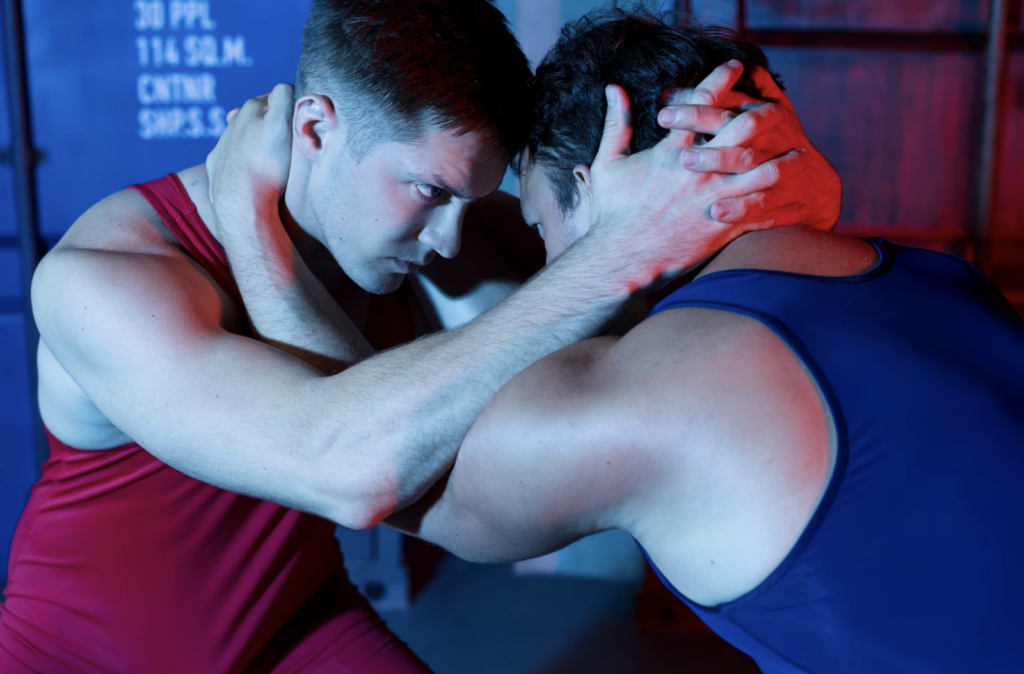High school wrestling, a dynamic and physically demanding sport, holds a special place within the realm of scholastic athletics. For many young athletes, it serves as a platform to test their strength, agility, and mental fortitude in the midst of intense competition. In this article, we’ll dive into the world of high school wrestling, examining its various forms, rules, benefits, and significance in the lives of students.
Understanding High School Wrestling: An Overview
High school wrestling encompasses various styles, each with its unique set of rules and techniques. The most common styles practiced in high school settings include folkstyle wrestling, freestyle wrestling, and Greco-Roman wrestling. While all three styles share the fundamental objective of pinning an opponent’s shoulders to the mat, they differ in rules, scoring, and permitted holds.
Folkstyle Wrestling: The Heart of High School Wrestling
Folkstyle wrestling, also known as collegiate wrestling, is the predominant style practiced in American high schools. This style emphasizes control, positioning, and strategy. Matches are divided into three periods, and points are scored through takedowns, escapes, reversals, near falls, and pins. Folkstyle wrestling encourages wrestlers to develop a well-rounded skill set that includes both offensive and defensive techniques.
Freestyle and Greco-Roman Wrestling: International Influences
While folkstyle wrestling is the cornerstone of high school wrestling in the United States, some schools and clubs introduce students to freestyle and Greco-Roman wrestling. Freestyle wrestling allows for more offensive moves, with a greater emphasis on throws and holds that may not be legal in folkstyle. Greco-Roman wrestling prohibits holds below the waist and focuses on throws that originate from upper body clinches. Exposure to these international styles can provide students with a broader perspective on the sport.
The Benefits of High School Wrestling
Engaging in high school wrestling offers a myriad of benefits that extend beyond the mat. Physically, wrestlers develop strength, endurance, flexibility, and cardiovascular fitness. The rigorous training regimen instills discipline, time management, and mental resilience, traits that prove invaluable both in academics and life outside of sports. Additionally, wrestling fosters camaraderie, sportsmanship, and a sense of belonging among teammates and opponents alike.
Navigating the Challenges
While high school wrestling offers numerous rewards, it’s not without its challenges. The demanding practice schedule, weight management, and the pressure of competition can be mentally and physically taxing for young athletes. Coaches and schools play a crucial role in ensuring the well-being of wrestlers by prioritizing safety, proper training techniques, and sportsmanship.
The Impact of High School Wrestling
High school wrestling extends beyond individual achievements, contributing to school spirit, community pride, and athletic legacy. Successful wrestlers inspire younger generations and become role models, epitomizing dedication and the pursuit of excellence. The sport leaves a lasting imprint on the lives of participants, shaping their character, work ethic, and outlook on challenges.
As the bright lights of the high school wrestling mat illuminate the determination and resilience of young athletes, it’s clear that this sport holds a unique place in scholastic sports. It not only hones athletic prowess but also cultivates qualities that prepare individuals for the journey ahead, both inside and outside the wrestling arena.

Is There a Difference Between Folkstyle Wrestling and Freestyle Wrestling?
Wrestling encompasses a variety of styles, each with its own rules, techniques, and origins. Two prominent styles that often spark curiosity are folkstyle wrestling and freestyle wrestling. While both share similarities due to their wrestling foundation, they differ significantly in terms of rules, scoring, and international recognition. Let’s delve into the distinctions between folkstyle and freestyle wrestling to gain a clearer understanding of these captivating sports.
Folk Style Wrestling
Folkstyle wrestling, also known as scholastic wrestling, is predominantly practiced in the United States, particularly at the high school and collegiate levels. This style is characterized by its emphasis on control and positioning. Wrestlers aim to dominate their opponents by securing and maintaining control on the mat. Folkstyle matches are typically conducted on a circular mat, and the wrestler who achieves control and accumulates points for takedowns, escapes, reversals, and near-falls is declared the winner.
Key Aspects of Folkstyle Wrestling:
- Control-Oriented: Folkstyle places a strong emphasis on controlling one’s opponent, often favoring techniques that allow the wrestler to maintain a dominant position;
- Scoring: Points are awarded for various actions, including takedowns (2 points), escapes (1 point), reversals (2 points), and near-falls (2 or 3 points);
- Top-Bottom Position: Wrestlers can choose to start from the top (riding) or bottom (neutral) positions, and the bottom wrestler’s goal is to escape or reverse the top wrestler;
- Mat Awareness: Wrestlers earn points for exposing their opponent’s back to the mat, leading to near-fall situations.
Freestyle Wrestling
Freestyle wrestling is an international style governed by United World Wrestling (UWW). It is widely practiced around the world and is an Olympic sport. Unlike folkstyle, freestyle wrestling encourages greater movement and agility. Wrestlers in freestyle aim to execute fast-paced actions, including throws, takedowns, and holds. The emphasis on explosive movements and quick transitions makes freestyle wrestling a dynamic and visually engaging sport.
Key Aspects of Freestyle Wrestling:
- Dynamic Techniques: Freestyle encourages high-impact throws and takedowns, making it visually captivating for spectators;
- Exposure Points: Wrestlers can earn points for exposing their opponent’s back to the mat, similar to folkstyle.
- Continuous Action: Freestyle wrestling places importance on maintaining continuous action and avoiding passivity, as inactivity can result in penalties;
- Par Terre Position: The par terre position (when one wrestler is on top and the other on the bottom) is essential for executing gut wrenches and other turning techniques;
- International Standard: Freestyle wrestling is recognized globally and is featured in international competitions and the Olympics.
| Aspect | Folk Style Wrestling | Freestyle Wrestling |
|---|---|---|
| Origin | United States | International |
| Control Emphasis | Strong emphasis on control and positioning | Encourages dynamic and agile movements |
| Scoring System | Points for takedowns, escapes, reversals, near-falls | Points for takedowns, throws, and exposure |
| Starting Positions | Choice of top, bottom, or neutral positions | Wrestlers often start from neutral position |
| International Recognition | Limited outside of the US | Recognized and practiced worldwide |
| Olympics | Not an Olympic sport | An Olympic sport |
In summary, while both folkstyle and freestyle wrestling share a common origin, they have evolved into distinct styles with unique rules and techniques. Folkstyle places an emphasis on control and position, while freestyle focuses on dynamic movements and explosive actions. Understanding the differences between these two styles enhances our appreciation for the art and athleticism of wrestling, whether on the scholastic stage or the global arena.
The Injury Rate of Wrestling: Most Common Injuries to Athletes
Wrestling is an intense and physically demanding sport that places significant strain on athletes’ bodies. While the sport offers numerous benefits, it’s important to acknowledge the potential risks and injuries that wrestlers may face. Let’s delve into the world of wrestling-related injuries and explore the most common types that athletes encounter on the mat.
- Sprains and Strains: Sprains and strains are among the most prevalent injuries in wrestling. The rapid and forceful movements involved in takedowns, escapes, and grappling can lead to overstretching or tearing of ligaments, tendons, and muscles. Commonly affected areas include the ankles, knees, shoulders, and wrists;
- Contusions and Bruises: Due to the close contact nature of wrestling, contusions and bruises are almost inevitable. Athletes frequently experience direct impact and friction against the mat and their opponents, resulting in discoloration, pain, and discomfort;
- Fractures and Dislocations: Though less common, fractures and dislocations can occur in high-impact situations or when athletes are caught in awkward positions. The force exerted during throws or the twisting of joints can lead to broken bones or the displacement of joints;
- Concussions: Concussions are a concern in any contact sport, including wrestling. While the risk of concussions is relatively lower compared to sports like football or hockey, the potential for head injuries exists. Collisions with opponents, the mat, or accidental impacts can lead to concussions, emphasizing the importance of protective headgear and proper technique;
- Skin Infections: Wrestlers are at risk of skin infections due to the close contact and sweat involved in the sport. Conditions such as ringworm, impetigo, and herpes gladiatorum can spread easily among athletes. Regular skin checks, proper hygiene, and maintaining clean practice environments are essential preventive measures;
- Shoulder Injuries: The shoulders are susceptible to injury, given the range of motions involved in wrestling. Takedowns, throws, and joint locks can strain the shoulder joints and muscles. Rotator cuff injuries, dislocations, and separations are potential outcomes of intense wrestling sessions;
- Knee Injuries: Knee injuries are a significant concern in wrestling, particularly due to the stress placed on the joints during grappling and movements. Ligament sprains, meniscus tears, and patellar injuries can result from sudden twists, pivots, or hyperextensions;
- Back and Neck Injuries: The twisting, bending, and forceful movements in wrestling can lead to back and neck injuries. Athletes may experience strains, muscle spasms, or even herniated discs. Proper posture, technique, and core strength are crucial for preventing these injuries.
Preventing Wrestling Injuries: Strategies and Precautions

While wrestling carries inherent injury risks, athletes, coaches, and parents can take proactive steps to mitigate these risks and ensure athletes’ safety. Implementing proper warm-up routines, practicing proper technique, maintaining conditioning and flexibility, and emphasizing injury prevention exercises are key strategies. Athletes should also adhere to weight management guidelines to avoid rapid weight loss, which can compromise their physical well-being.
Moreover, fostering a culture of open communication between coaches, athletes, and parents can encourage timely reporting of injuries and concerns. Regular medical check-ups and addressing injuries promptly can significantly contribute to wrestlers’ long-term health and well-being.
| Injury Type | Description |
|---|---|
| Sprains and Strains | Overstretching or tearing of ligaments, tendons, and muscles. |
| Contusions and Bruises | Discoloration and pain due to impact and friction. |
| Fractures and Dislocations | Broken bones or displaced joints. |
| Concussions | Head injuries resulting from collisions or impacts. |
| Skin Infections | Infections due to close contact and sweat. |
| Shoulder Injuries | Strains, dislocations, and joint issues. |
| Knee Injuries | Ligament sprains, tears, and patellar injuries. |
| Back and Neck Injuries | Strains, spasms, and disc issues. |
Conclusion
In conclusion, while the sport of wrestling offers numerous physical and mental benefits, it’s important to acknowledge the potential for injuries. Wrestlers and those involved in the sport should prioritize safety, proper technique, and preventive measures to ensure that athletes can enjoy the sport while minimizing the risk of injuries that may hinder their performance and well-being.